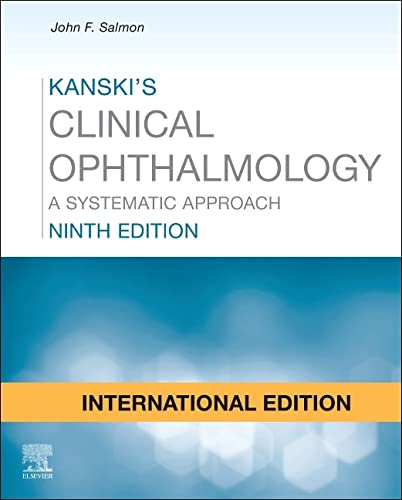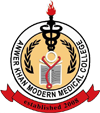Anwer Khan Modern Medical College
Library Management System

| Title: | Kanski's clinical ophthalmology: a systematic approach |
| Author Name: | John F. Salmon |
| Author Sur Name: | SALMON, John F. |
| Author information: |
|
| Edition/Published: | 9th ed. _London : Elsevier , 2020 |
| New to this edition: |
|
|
Physical Description: : <p>xiii, 941 pages: illustrations (chiefly color); 18 cm</p>.; |
| Notes | Includes bibliographical references & indexes. |
| Includes Index: | 917-941 |
| ISBN No's: | 978-0-7020-7712-8 |
| Bar Code's: | |
| Shelf Location's: |
| Classification | |
| Subject: | Ophthalmology |
| Dewey Class No: | 617.7 |
| LC Classification: | RE46 .K35 2020 |
| Other's Book Information | |
| Book ID No: | 2621 |
| Total Books: | 1 |
| Date of collection's: | 30-Dec-2021 |
| Donation / Purchase: | Purchased |
| Language: | English |
| Status: | Available |
| Department: | Ophthalmology |
| Synopsis: |
|
| Review: |
|
| Description: |
|
| Key Features: |
|
| Summary: |
Kanski's clinical ophthalmology is a comprehensive textbook that provides an overview of the most common ocular diseases. The 9th edition of the covers topics such as dry eye, glaucoma and retinal detachment.The taxt is organized into chapters thst cover different areas of ophthalmology . such as diseases of the cornea and diagnosis and treatment of papilledema. the book utilizes targeted text, bulleted lists, tables and visual aids to highlight salient points ocross all of itscontent. Addititionally, the book has been revised and expanded to include many, new color illustration. Along with the textbook there is a companion handbook titled Kanski's synopsis of clinical ophthalmology, which distills the key information from clinical ophthalmology into a pritable format. Overall, Kanski's ophthalmology is a valuable resources for anyone studying or practicing ophthalmology. |
| Abstract: |
Kanski's Clinical Ophthalmology is a comprehensive textbook that provides a detailed overview of the diagnosis and management of various ocular disorders. The book covers a wide range of topics, including the anatomy and physiology of the eye, the principles of ophthalmic examination and investigation, and the medical and surgical management of ocular diseases. The ninth edition of the book, published in 2019, includes updated information on advances in diagnostic imaging techniques, surgical techniques, and pharmacological therapies, as well as expanded sections on pediatric ophthalmology and ocular manifestations of systemic diseases. With over 1,000 pages of information, Kanski's Clinical Ophthalmology is an essential resource for ophthalmologists, optometrists, and other healthcare professionals involved in the care of patients with ophthalmic disorders. |
| Preface: |
In presenting this new edition of Kanski’s Clinical Ophthalmology, I am reminded of a quotation from Lewis Carroll’s Alice’s Adventures in Wonderland: “What is the use of a book”, thought Alice, “without pictures or conversations?”. The ninth edition of this classic textbook is filled with beautiful illustrations and considerable information and is intended to be a useful and comprehensive basis for general ophthalmic practice. It has been a privilege to work on this remarkable book and I am grateful to Jack Kanski and the staff of Elsevier for entrusting me with the task. The challenge has been to cover the entire field of ophthalmology for a worldwide audience without depending on subspecialists to prepare each chapter. In order to do this, I have maintained Jack Kanski’s unique approach of presenting core clinical knowledge in a systemic and succinct form. Brad Bowling has had a significant influence on the two previous editions and his accuracy and meticulous attention to detail has been extremely helpful. I have reverted to the format that was used in the sixth edition by starting with an initial chapter on examination techniques. Special investigations remain in the chapters where they are most relevant. Each chapter has been updated and the latest evidence-based diagnostic and therapeutic approaches have been covered, including genetics, immunotherapy and imaging techniques. Many new illustrations have been added and better examples of a range of conditions have been used. Jack Kanski’s idea of including important ‘tips’ has been reintroduced. I have included sufficient practical information for trainees to manage common ophthalmic conditions in the clinic and enough detail on rare conditions to enable them to prepare for their examinations without resorting to the Internet. I have been extremely fortunate to have received help from colleagues past and present, to whom I wish to express my grateful thanks. The photographers and research staff at the Oxford Eye Hospital have been wonderfully supportive. Jack Kanski generously gave me his huge collection of images. My friends in South Africa, Tony Murray (strabismus) and Trevor Carmichael (cornea) provided help with the text and images of pathology that are not easily found in developed countries. I received many pictures from Jonathan Norris and Elizabeth Insull (oculoplastics), Darius Hildebrand and Manoj Parulekar (pediatrics), Peter Issa and Christine Kiire (medical retina), Bertil Damato (ocular oncology), Martin Leyland (corneal surgery), C.K. Patel (vitreoretinal surgery), Patsy Terry (ultrasound) and Pieter Pretorius (neuroradiology). Mitch Ménage provided good pictures of common conditions. Aude Ambresin and Carl Herbort (Switzerland) supplied state-of-the-art retinal images. I have kept many of the outstanding pictures that Chris Barry and Simon Cheng (Australia) provided for the eighth edition. Single examples of rare conditions have been kindly provided by a number of colleagues throughout the United Kingdom and elsewhere and their contribution has been recognized next to the images provided. Other individuals have helped substantially with previous editions of Clinical Ophthalmology, including Terry Tarrant, the artist who produced the meticulous ocular paintings. I also wish to thank Kim Benson, Sharon Nash, Kayla Wolfe, Julie Taylor, Anne Collett, and the production team at Elsevier. The ninth edition of Kanski’s Clinical Ophthalmology could not have been produced in the time available without the help of my assistant, Carolyn Bouter, whose resilience, diligence, intelligence, and skill were evident throughout the 6 months that she worked with me. I have also had the good fortune to work with Jonathan Brett is a world-class photographer, and artist, whose genius is present in hundreds of the images included in this edition. My wife, Susie, has been extremely supportive throughout this project and her happy and helpful nature has made the task a pleasant and enjoyable experience.
John F. Salmon 2019 |
| Content: |
Dedication.......................................................................viii In Memoriam.....................................................................ix Preface to the Ninth Edition................................................x Abbreviations.....................................................................xi 1 Examination Techniques................................................1 Introduction.......................................................................2 Psychophysical tests........................................................2 Perimetry..........................................................................9 Slit lamp biomicroscopy of the anterior segment.............20 Fundus examination........................................................21 Tonometry.......................................................................27 Gonioscopy.....................................................................30 Central corneal thickness...............................................36 2 Eyelids.........................................................................37 Introduction.....................................................................38 Non-neoplastic lesions....................................................39 Benign epidermal tumours...............................................43 Benign pigmented lesions................................................44 Benign adnexal tumours..................................................47 Miscellaneous benign tumours.........................................47 Malignant tumours...........................................................50 Disorders of the eyelashes...............................................60 Allergic disorders.............................................................66 Immune-related inflammation..........................................66 Bacterial infections..........................................................67 Viral infections.................................................................68 Blepharitis.......................................................................70 Ptosis..............................................................................74 Ectropion.........................................................................80 Entropion.........................................................................85 Miscellaneous acquired disorders....................................87 Cosmetic eyelid and periocular surgery............................91 Congenital malformations................................................93 3 Lacrimal Drainage System............................................99 Introduction......................................................................100 Acquired obstruction.........................................................105 Congenital obstruction......................................................108 Chronic canaliculitis..........................................................109 Dacryocystitis...................................................................110 4 Orbit...............................................................................113 Introduction.......................................................................114 Thyroid eye disease..........................................................118 Infections...........................................................................124 Non-infective inflammatory disease...................................126 Non-neoplastic vascular abnormalities...............................129 Cystic lesions......................................................................131 Vascular tumours................................................................134 Lacrimal gland tumours........................................................140 Neural tumours.....................................................................142 Lymphoma............................................................................144 Rhabdomyosarcoma............................................................147 Metastatic tumours...............................................................148 The anophthalmic socket.....................................................150 Craniosynostoses................................................................153 5 Dry Eye............................................................................155 Introduction.........................................................................156 Sjögren syndrome...............................................................158 Clinical features...................................................................158 Investigation........................................................................159 Treatment............................................................................162 6 Conjunctiva.....................................167 Introduction...................................................................168 Bacterial conjunctivitis...................................................171 Viral conjunctivitis..........................................................177 Allergic conjunctivitis.....................................................180 Conjunctivitis in blistering mucocutaneous disease........188 Miscellaneous disorders of the conjunctiva....................194 Degenerations...............................................................197 Subconjunctival haemorrhage........................................200 7 Cornea............................................203 Introduction...................................................................204 Bacterial keratitis...........................................................209 Fungal keratitis..............................................................216 Herpes simplex keratitis.................................................218 Herpes zoster ophthalmicus...........................................224 Interstitial keratitis.........................................................229 Protozoan keratitis.........................................................232 Helminthic keratitis........................................................234 Bacterial hypersensitivity-mediated corneal disease..........................................................234 Rosacea........................................................................236 Peripheral corneal ulceration/thinning...........................238 Neurotrophic keratopathy...............................................241 Exposure keratopathy.....................................................242 Miscellaneous keratopathies..........................................243 Corneal ectasia..............................................................248 Corneal dystrophy..........................................................252 Corneal degeneration.....................................................261 Metabolic keratopathy....................................................266 Contact lenses...............................................................268 Congenital anomalies of the cornea and globe...............270 8 Corneal and Refractive Surgery........275 Keratoplasty..................................................................276 Keratoprostheses...........................................................283 Refractive procedures....................................................283 9 Episclera and Sclera..................................................291 Anatomy........................................................................292 Episcleritis.....................................................................292 Immune-mediated scleritis.............................................293 Porphyria.......................................................................300 Infectious scleritis..........................................................300 Scleral discolouration....................................................301 Blue sclera....................................................................301 Miscellaneous conditions...............................................302 10 Lens..........................................................................307 Acquired cataract..........................................................308 Management of age-related cataract..............................311 Congenital cataract........................................................335 Ectopia lentis.................................................................338 Abnormalities of lens shape...........................................342 11 Glaucoma.................................................................345 Introduction...................................................................346 Ocular hypertension.......................................................347 Overview of glaucoma....................................................349 Primary open-angle glaucoma.......................................349 Normal-tension glaucoma..............................................367 Primary angle-closure glaucoma....................................370 Classification of secondary glaucoma............................378 Pseudoexfoliation..........................................................379 Pigment dispersion syndrome and pigmentary glaucoma.................................................381 Neovascular glaucoma...............................................383 Inflammatory glaucoma.................................................385 Steroid-induced glaucoma.............................................388 Lens-related glaucoma..................................................389 Traumatic glaucoma.......................................................390 Ghost cell ‘glaucoma’.....................................................392 Iridocorneal endothelial syndrome.................................392 Glaucoma associated with intraocular tumours..............394 Glaucoma secondary to epithelial ingrowth....................394 Iridoschisis....................................................................395 Primary congenital glaucoma.........................................395 Iridocorneal dysgenesis..................................................399 Glaucoma in phacomatoses...........................................403 Medical treatment of glaucoma......................................404 Laser treatment of glaucoma.........................................407 Trabeculectomy..............................................................412 Non-penetrating glaucoma surgery.................................419 Minimally invasive glaucoma surgery (MIGS)..................420 Drainage shunts.............................................................421 12 Uveitis.............................................423 Classification.................................................................424 Clinical features.............................................................424 Investigation..................................................................429 Treatment.......................................................................432 Immunomodulatory therapy for non-infectious uveitis.................................................433 Uveitis in spondyloarthropathies....................................435 Fuchs uveitis syndrome..................................................437 Uveitis in juvenile idiopathic arthritis (JIA)......................439 Uveitis in bowel disease.................................................441 Uveitis in renal disease..................................................442 Intermediate uveitis.......................................................443 Vogt–Koyanagi–Harada (VKH) syndrome.........................445 Sympathetic ophthalmitis..............................................448 Lens-induced uveitis......................................................449 Sarcoidosis....................................................................450 Behçet disease..............................................................454 Parasitic uveitis..............................................................456 Viral uveitis....................................................................465 Fungal uveitis.................................................................473 Bacterial uveitis.............................................................477 Miscellaneous idiopathic chorioretinopathies.................484 13 Retinal Vascular Disease..................495 Retinal circulation..........................................................496 Diabetic retinopathy.......................................................496 Non-diabetic retinopathy................................................513 Retinal venous occlusive disease...................................514 Retinal arterial occlusive disease...................................525 Ocular ischaemic syndrome...........................................531 Hypertensive eye disease...............................................532 Sickle-cell retinopathy....................................................533 Thalassaemia retinopathy..............................................536 Retinopathy of prematurity.............................................536 Retinal artery macroaneurysm.......................................540 Primary retinal telangiectasia.........................................543 Eales disease................................................................546 Radiation retinopathy.....................................................546 Purtscher retinopathy.....................................................547 Valsalva retinopathy.......................................................549 Lipaemia retinalis..........................................................549 Retinopathy in blood disorders.......................................550 14 Acquired Macular Disorders......................................555 Introduction...................................................................556 Clinical evaluation of macular disease...........................557 Investigation of macular disease....................................558 Age-related macular degeneration..................................572 Retinal angiomatous proliferation...................................589 Polypoidal choroidal vasculopathy..................................589 Peripheral exudative haemorrhagic chorioretinopathy.......................................................591 Idiopathic choroidal neovascularization..........................591 Vitreomacular interface disorders...................................592 Central serous chorioretinopathy....................................598 Idiopathic macular telangiectasia...................................601 Cystoid macular oedema...............................................602 Microcystic macular oedema..........................................604 Degenerative myopia......................................................604 Angioid streaks..............................................................607 Choroidal folds..............................................................609 Hypotony maculopathy...................................................610 Solar retinopathy...........................................................610 Focal choroidal excavation.............................................611 Dome-shaped macula...................................................612 Low visual aids..............................................................613 15 Hereditary Fundus Dystrophies.........615 Introduction...................................................................616 Investigation..................................................................616 Generalized photoreceptor dystrophies...........................619 Macular dystrophies.......................................................631 Generalized choroidal dystrophies..................................640 Hereditary vitreoretinopathies........................................641 Albinism........................................................................649 Cherry-red spot at the macula.......................................652 16 Retinal Detachment.........................653 Introduction...................................................................654 Peripheral lesions predisposing to retinal detachment.....................................................657 Posterior vitreous detachment........................................663 Retinal breaks................................................................666 Rhegmatogenous retinal detachment.............................668 Tractional retinal detachment.........................................681 Exudative retinal detachment.........................................681 Pars plana vitrectomy.....................................................683 17 Vitreous Opacities...........................691 18 Strabismus......................................697 Introduction...................................................................698 Amblyopia.....................................................................707 Clinical evaluation..........................................................708 Pseudostrabismus.........................................................726 Heterophoria..................................................................727 Vergence abnormalities..................................................727 Esotropia.......................................................................728 Exotropia.......................................................................733 Congenital cranial dysinnervation disorders....................735 Monocular elevation deficiency......................................737 Brown syndrome............................................................737 Alphabet patterns..........................................................738 Surgery..........................................................................739 Complications of strabismus surgery..............................742 Botulinum toxin chemodenervation................................743 19 Neuro-ophthalmology.......................745 Neuroimaging................................................................746 Optic nerve....................................................................751 Pupils............................................................................779 Chiasm..........................................................................786 Retrochiasmal pathways................................................792 Ocular motor nerves.......................................................795 Supranuclear disorders of ocular motility.......................806 Nystagmus.....................................................................809 Ocular myopathies.........................................................814 Miller Fisher syndrome...................................................819 Neurofibromatosis.........................................................819 Migraine........................................................................820 Neuralgias.....................................................................823 Facial spasm.................................................................824 Disorders of circadian rhythm.........................................825 Neuro-ophthalmology of space flight..............................825 20 Ocular Tumours................................827 Benign epibulbar tumours..............................................828 Malignant and premalignant epibulbar tumours.............833 Iris tumours...................................................................839 Iris cysts........................................................................841 Ciliary body tumours......................................................843 Tumours of the choroid..................................................846 Neural retinal tumours...................................................860 Retinal vascular tumours................................................868 Primary intraocular lymphoma.......................................872 Tumours of the retinal pigment epithelium......................875 Paraneoplastic syndromes.............................................878 21 Ophthalmic Side Effects of Systemic Medication....882 Cornea..........................................................................882 Ciliary effusion...............................................................882 Lens..............................................................................883 Uveitis...........................................................................884 Retina............................................................................884 Optic nerve--------------------------------------------------------891 Eyelid trauma.................................................................892 Orbital trauma...............................................................894 Trauma to the globe.......................................................898 Chemical injuries...........................................................912 Thermal burns................................................................916 Index.............................................................................917 |
